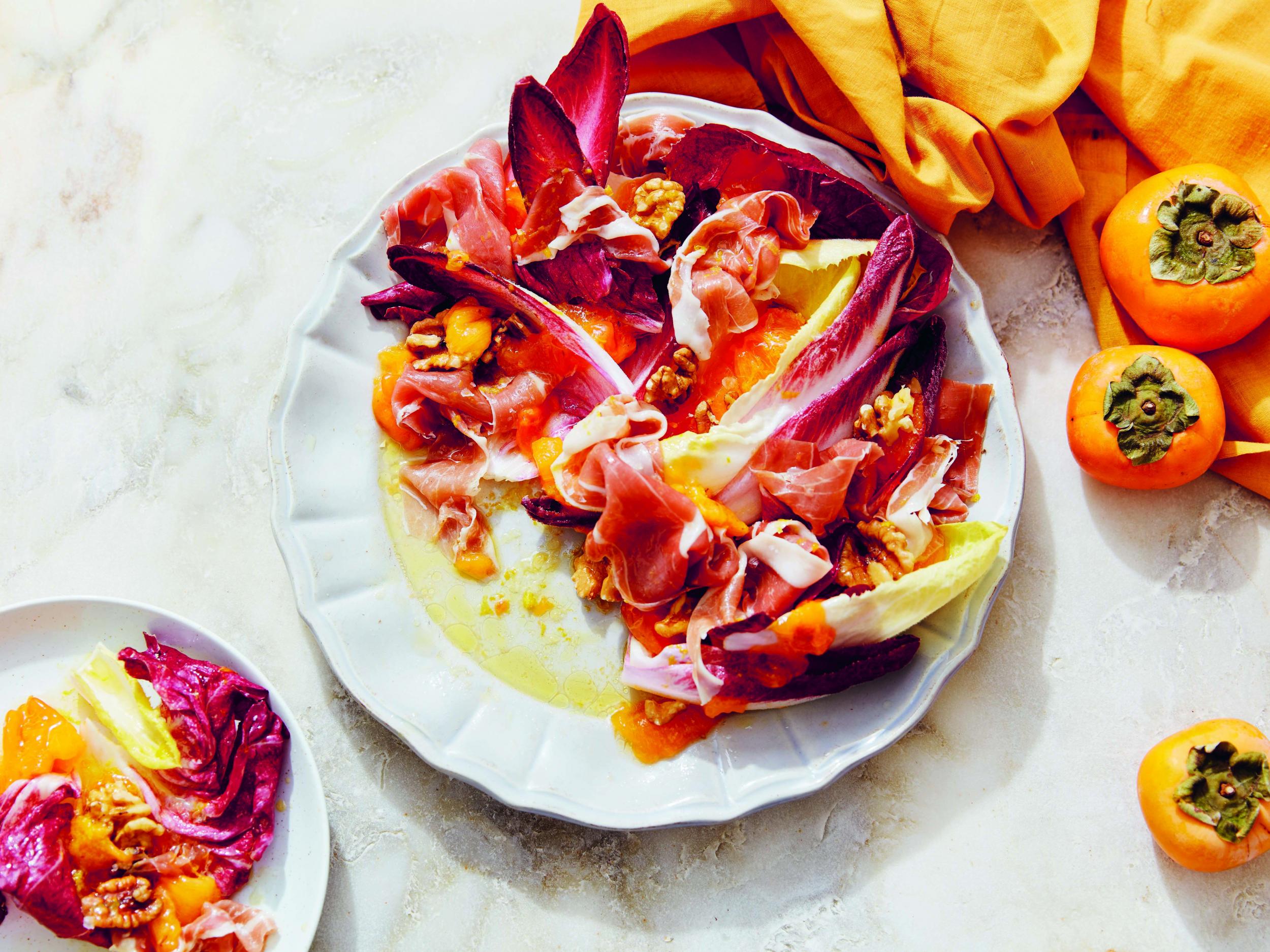‘Bitter Honey’ cookbook: Recipes from blood orange cake to persimmon and prosciutto salad
As it looks like summer holidays are out of the question, now is the time to cook the recipes of the places you’d rather be. Travel to Sardinia with Letitia Clark’s debut cookbook

Persimmon, prosciutto, endives and walnuts
A delicious combination of things that all happen to come into season here in late autumn.
The kind of persimmons most often grown here are the hachiya, which become so soft when ripe that they collapse at the touch of a finger. The flavour is hard to describe: a little honey, a little vanilla, a lot of sweetness.
They cry out for acidity. Here, they are paired with some salt, some bitterness and some crunch. The orange juice and zest in the dressing brings out the best in the persimmon.
Serves 4-6
2½ tbsp olive oil
Zest and juice of 1 orange
Juice of 1 lemon
Pinch of sea salt
2 ripe persimmons
2 heads endive or other bitter leaf, such as radicchio, or a combination
4-6 slices prosciutto
1 handful of walnuts
Make a dressing by whisking the oil, citrus juices, zest and salt. Scoop out the flesh of the persimmons and arrange them in amber blobs on a serving plate. Dress the leaves in a large bowl with most of the dressing and tumble them over the persimmon.
Drizzle extra dressing on the persimmon, lay over the slices of prosciutto and scatter the walnuts over. Serve.
Slow-cooked courgettes with mint, chilli and almonds
The courgette, like the aubergine, is something the Italians understand well. They know that liberal oil is the key to unlocking the sweet nuttiness of this water-heavy vegetable. In this recipe, the courgettes are cooked long and slow, in plenty of olive oil, with a sprinkling of dried chilli and lots of finely sliced garlic.
The resulting luxurious combination is delicious on its own, served with a scattering of mint and some toasted almonds as a standalone dish, or as a silky bed on which to pile pork chops or roast chicken. After eating them like this, you’ll never think ill of a courgette again. I love mint here, but any soft herb is good (dill, tarragon, basil or parsley). I can taste almonds in courgettes. If you try this combination, maybe you will not think me completely mad.
Seves 4-6
5 tbsp olive oil
3 garlic cloves, finely sliced
700g courgettes, halved and thinly sliced widthways
1 dried chilli, crumbled, or a pinch of chilli flakes
Sea salt
Handful of mint leaves, chopped
Pinch of lemon zest
2 tbsp almonds, toasted and chopped roughly
In a heavy lidded frying pan (skillet) over a medium heat, warm the oil and then add the garlic and the courgettes. Add the chilli and cook over a medium-low heat, stirring occasionally, so that the courgettes begin to take some colour and caramelise. After 5-10 minutes, when a fair few of the courgettes have caramelised, place the lid of the pan on and turn the heat down.
Cook for another 10 minutes, stirring occasionally; if they begin to catch, add a splash of water. Once softened, taste and season. Add the chopped mint, lemon zest and almonds just before serving. This is best eaten at room temperature, with crusty bread and cheese.
Blood orange, ricotta, polenta and olive oil cake
A perfect cake, this is simultaneously fluffy, rich and light. The polenta gives it a lovely crunchiness at the edges. It will stay soft and sticky for days, though it is unlikely it will last that long – it is especially delicious for breakfast with an espresso. Blood oranges look the most striking with their scarlet flesh, but normal oranges will work just as well. A final note: this batter will look very runny when it is made, but do not be alarmed. It is all exactly as you planned...
Serves 8-10
For the base
1-2 blood oranges
100g demerara sugar
For the batter
200ml olive oil, plus extra for greasing
200g caster sugar
Pinch of sea salt
250g ricotta
Zest and juice of 4 small blood oranges
Juice and zest of 1 large lemon
4 eggs
100g polenta
150g plain flour
2 tsp baking powder
Preheat the oven to 180C/gas 4. Grease and line a 20cm cake tin. First, prepare the base of the cake. Wash the oranges and slice them into 2 mm discs with a very sharp knife (you can use a mandoline or a slicer if you have them). I leave the rind on, as when cooked like this it becomes edible, but if you prefer you can remove it.
In a small saucepan over a medium heat, melt the demerara sugar with 2 tablespoons of water until it has dissolved. Simmer for a few minutes until the syrup begins to caramelise (you should smell and see the colour change to a light amber). Pour your syrup over the bottom of the cake tin. Arrange the slices of blood orange, as many as will fit in one layer in a pleasing pattern, on top of the syrup.
To make the batter, whisk the oil, sugar, salt, ricotta, citrus juice and zest together in a large mixing bowl. Add in the eggs one at a time and beat until smooth. Add in the dry ingredients and beat until smooth. Pour the batter into the prepared tin and bake for 40-50 minutes, until golden and just set.
Allow the cake to cool for 5 minutes, then run a knife around the edge of the tin and invert onto a wire rack or serving plate. Allow to cool completely before slicing.
‘Bitter Honey’ by Letitia Clark (Hardie Grant, Hardback and eBook) Photography by Matt Russell
Subscribe to Independent Premium to bookmark this article
Want to bookmark your favourite articles and stories to read or reference later? Start your Independent Premium subscription today.

Join our commenting forum
Join thought-provoking conversations, follow other Independent readers and see their replies